 Image search results - "Peninsula" Image search results - "Peninsula" |

Karasuma Peninsula in Kusatsu. There is a large lotus pond behind the windmill. About 20 min. by bus from JR Kusatsu Station.
|
|

Tango Peninsula in northern Kyoto Prefecture is scenic along the coast with a number of natural features and formations.Much of the coast is part of the San'in Kaigan Geopark (山陰海岸ジオパーク) that extends from the western half (Kyotango city) of Tango Peninsula to Tottori Prefecture. San'in Kaigan Geopark is also a UNESCO Global Geopark.
|
|

These photos were taken while cycling along the Tango Peninsula.
|
|

Tango Peninsula coast.
|
|

Tango Matsushima (pine islands).
|
|

Tango Matsushima (pine islands).
|
|

Byobu Iwa rock.
|
|

Tateiwa Rock on the Tango Peninsula, northern Kyoto. The swimming beach leading to Tateiwa is named Tateiwa Nochigahama (立岩後ヶ浜海水浴場).
|
|

Tateiwa Rock on Tango Peninsula.Map (Tateiwa): https://goo.gl/maps/QDHmG1qArez
|
|

About Tateiwa Rock.
|
|

How Tateiwa Rock formed. This large mass of volcanic rock formed when the magma erupted and accumulated within the earthen strata below the surface. The magma didn't break the surface. However, the surrounding strata was soft and eventually eroded to expose only this hard volcanic rock called Tateiwa (Standing Rock).
|
|

Tateiwa Rock
|
|

Tateiwa Rock
|
|
|
|

San'in Kaigan Geopark (山陰海岸ジオパーク) area.
|
|

San'in Kaigan Geopark (山陰海岸ジオパーク)
|
|

San'in Kaigan Geopark (山陰海岸ジオパーク) from Kyoto to Tottori.
|
|
|

Visited a Tango chirimen company called Tayuh Textile Co., Ltd. (Tayuh Kigyo 田勇機業株式会社). http://www.tayuh.jp/
|
|

Tayuh Textile Co.'s chirimen textile factory in Kyotango.
|
|

Lobby of Tayuh Textile Co.
|
|

First we saw Tayuh Textile Co.'s gift shop and showroom.
|
|

Tayuh Kigyo's third-generation company president Tamoi Hayato (田茂井 勇人) first explained about their chirimen manufacturing process.These looping punch cards called "mon-gami" (紋紙) program the Jacquard loom to weave the design on the fabric. The holes in the punch cards tell the loom which threads are to be raised or not during the weaving process. These punch cards can be made by computer now.
|
|

He showed us the finished product, a chirimen fabric with a woven design.
|
|

This is 3,000 silk cocoons. That's how much silk is needed to make silk fabric for one kimono. One cocoon has 1200–1500 meters of silk thread. Since Japan produces very little silk, most are imported from China and Brazil. The Tango region consumes about one-third of Japan's raw silk imports. We were told the quality of silk from China and Brazil is very good.
|
|

Tayuh Kigyo's company motto: "A company that boasts quality has a future."
|
|

Tayuh Textile Co. makes almost everything, from the silk threads to the fabrics. We toured their impressive factory. These are spools of silk being made into threads.
|
|
|
|

This is a thread twister to twist the horizontal silk threads (weft) 3,000 to 4,000 times. This is a key step and how chirimen gets its crimped surface. After being woven into the fabric, the highly twisted weft threads try to untwist, creating the crimping.
|
|
|
|
|
|

Tayuh Kigyo's factory has 60 mechanized looms (50 of them are Jacquard looms).
|
|

Very noisy and very fast-moving. One employee monitors several looms.
|
|
|
|
|
|

Fascinating to watch.
|
|
|
|
|

Within Tayuh Kigyo's factory grounds, there's also the Garden of Hosenju (蓬仙寿の庭) designed by Shigemori Mirei (1896–1975 重森三玲), a famous Japanese garden designer.
|
|

Garden of Hosenju (蓬仙寿の庭), Kyotango, Kyotohttp://www.tayuh.jp/
|
|
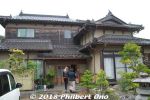
Tango chirimen silk fabric maker Tamiya Raden (民谷螺鈿).
|
|

Tamiya Raden (民谷螺鈿) had this stunning silk kimono on display for us. "Raden" means inlay (using shell, ivory, etc.). Typically, we think of lacquerware, but they do it on fabrics. This kimono took 2.5 years to make and is worth more than a Lamborghini or Rolls Royce.
|
|

Company president Tamiya Kyoji answered our many questions about this amazing kimono. His father Tamiya Katsuichiro took two years to develop and invent a method to inlay shell pieces in fabrics and showed their first example on a kimono obi sash in 1977.
|
|

The kimono was woven with pearly shell pieces from five species of oysters. Might be hard to see which parts of the kimono are the shell inlay, but the shiny parts are not the shell pieces. Very glittery.
|
|
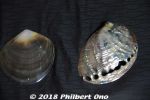
Pearly shells used in their fabrics.
|
|

First they attach the thin shell/pearly layers on a design on washi paper.
|
|

It's a painstaking, time-consuming process.
|
|

The completed design on washi paper is then sliced into "threads" that will be woven into the fabric.
|
|

Working on an obi sash.
|
|

Working on an obi sash.
|
|
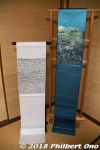
Tamiya Raden also makes kimono obi sashes.They also supply fabrics to world-famous luxury brands, but they can't brag about it because of a non-disclosure agreement.
|
|

This is a replica of an obi sash that was selected and worn by Empress Michiko recently for her birthday.The company is especially proud of this, but can't publicly brag about it. (The empress does not know who made the obi. She just liked the design.)
http://tamiya-raden.jp/
|
|

Another stop was a Tango chirimen wholesaler named Yoshimura Shouten (株式会社 吉村商店 峰山支店). Founded in 1830 and based in Kyoto city, this is their branch shop in in Mineyama, Kyotango.
|
|

They are in this distinctive, traditional building rebuilt in 1930 after the big 1927 Tango earthquake.
|
|
|

Inside Yoshimura Shouten. They have a small office space on the right, meeting room on the left, a fireproof kura storehouse in the back, and lots of floor space for textile merchandise.
|
|

Mineyama Branch Manager Yoshioka Hitoshi shows a PR poster of Bando Tamasaburo V posing with a Tango chirimen fabric in front of the shop's kura storehouse near where Yoshioka is standing.Tamasaburo V is one of the most famous and popular kabuki actors in Japan and Living National Treasure. He loves Tango chirimen fabrics and kabuki costumes also use Tango chirimen.
|
|

Inside their kura storehouse.
|
|

Yoshimura Shouten also creates its own designs like this "Hollywood chirimen" prototype with the the likeness of Audrey Hepburn, Charlie Chaplin, and Marilyn Monroe.
|
|

Chirimen fabric inspector uses a light box to carefully check for any defects and flaws in the material. Any defects in the material will reduce its value and the fabric (or kimono) will be sold for less.
|
|

Seal of approval on chirimen fabric.
|
|
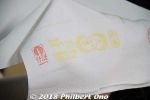
Seal of approval on chirimen fabric. Although Yoshimura Shouten is mainly a wholesaler, they also sell fabrics to individuals.http://yoshimura-shouten.jp/
|
|

He even waved goodbye to us!
|
|

Banner commemmorating the 300th anniversary of Tango chirimen in 2018.
|
|

This is Shorenkan Yoshinoya (昭恋館よ志のや), a hot spring ryokan on the Tango Peninsula (Kyotango). Founded in 1928, it has 11 guest rooms.
|
|

Lobby entrance.
|
|

Lobby
|
|

Nice Japanese-style room.
|
|

View from my room.
|
|

View from my room.
|
|

This is the dressing room for the bath named "Shoren-no-Yu" (昭恋の湯). (“Shoren” means “Love of the Showa Period.” And “Yu” means hot spring water.)The ryokan had two hot spring baths, and both were designed by an American.
|
|

Dressing room.
|
|

Entrance to the bath area.
|
|

The "Shoren-no-Yu" (昭恋の湯) bath was originally an abandoned building that was renovated into a bath with a high ceiling and garden. Most everything was designed by Alexander Wilds and his artist wife Yukiko Oka. Wilds is an American sculptor from New Orleans living in Japan since 1985. He currently teaches art at Yamanashi Gakuin University in Kofu, Yamanashi Prefecture.
|
|
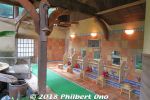
For Shoren-no-Yu, Alexander Wilds and his artist wife Yukiko Oka designed and built most everything including the garden. The shelves in the dressing room were made by his friend. Stained glass was made by his mother. Ceramic tiles are Mexican, leftover from a previous project of his. The bathhouse was originally an abandoned house which he stripped.
|
|

Since the ryokan celebrates the Showa Period (implied by the name "Shorenkan"), he aimed to make the bath have a Showa/Taisho Period feel. It was a tough job because they had to haul everything in and out manually. No accessible road so they had to roll the wooden barrel tub to the building manually (it couldn’t be rectangular). This bath was built during June to Oct. 2003.
|
|

The bath in a wooden barrel. They allowed men and women to use this bath on alternate days.http://alexanderwilds-japan.blogspot.com/2017/12/alexander-wilds-architecture-yoshinoya.html
|
|

Facing the bath's garden area.
|
|

This is the other bath named “Vidro-no-Yu” (ビードロの湯) and also designed by Alexander Wilds and his artist wife Yukiko Oka. The indoor part. The glass windows were a design highlight (hard to see because of the steam and dark night). The glass door opens to a balcony with a bath.
|
|

Outdoor baths on the balcony. It was night so I couldn't see the scenery. But it was great that we could try these two different baths during our overnight stay.
|
|
|

Indoor bathing area.
|
|

Dining room.
|
|
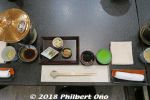
Dinner started with this.
|
|
|

Shorenkan Yoshinoya ryokan is probably more famous for its food, especially crab during crab season (Nov. to March). But it wasn't crab season when we were there so we didn't have any crab. But the food was still excellent. Kyotango, Kyoto Prefecture.
|
|
|

Yuzu sherbet. Yummy!
|
|
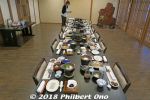
Breakfast.
|
|

BreakfastShorenkan Yoshinoya Map: https://goo.gl/maps/hAHehEVDsft
http://taiza.jp/en/
|
|

Tasted more local food here at Heshiko Kobo Hisami (へしこ工房 Hisami), a restaurant/shop in Kyotango.Map: https://goo.gl/maps/Jq7NoojH59s
http://www.hisami-kasade.com/page/shop.php#heshiko
|
|

Inside Heshiko Kobo Hisami.
|
|

A local fish delicacy called "heshiko." Heshiko is made in this coastal region of Kyoto and Fukui Prefectures. It uses mackerel (saba), sardines (iwashi), or Pacific saury (sanma) that are salted and then fermented in rice bran (nuka). For heshiko, mackerel is most popular and the process takes two years. It is a traditional way to preserve fish for later consumption without refrigeration. It was a common (and cheap) food for the masses, but now it's a delicacy.
This restaurant believes too much salt is not so healthy, so they take only two weeks to salt and ferment the fish. This method is called asazuke (浅漬け) which means "lightly pickled." We sampled the mackerel prepared this way (and grilled), but I thought it was very salty already and hardly any taste of fermentation.
|
|

Heshiko for sale.
|
|

Lake Biwa Museum has a world-class freshwater aquarium showing Lake Biwa's endemic species and more. Open 9:30 am - 5 pm, closed Mon. and the day after a national holiday. Admission 600 yen for adults.It shows Lake Biwa's history, fish and wildlife, coexistence with people, and a large lake-fish aquarium. It is also a research facility with a number of researchers and curators.
|
|

Main entrance. Open 9:30 am - 5 pm, closed Mon. and the day after a national holiday. MAPNote that the museum underwent major renovations and reopened in July 2016. Some of the old exhibits have been replaced and there are also new exhibits like Lake Baikal seals.
|
|

Take a bus from JR Kusatsu Station. Admission 750 yen for adults. MAP
|
|

The photos in this album are video stills taken from my Lake Biwa Museum video.
|
|

Entrance hall atrium
|
|

My comprehensive video about Lake Biwa's endemic species and invasive species displayed at the Lake Biwa Museum's freshwater aquarium.
|
|

About Lake Biwa
|
|

Lake Biwa's North Basin.
|
|

View from Mt. Hiei Driveway.
|
|

Lake Biwa's South Basin.
|
|

Lake Biwa Museum's freshwater aquarium displays fish species endemic to Lake Biwa, found no where else.
|
|

Definitions of endemic, native, endangered, and invasive species.Native species (在来種)
Naturally inhabits Lake Biwa or Shiga and not introduced by man. May also inhabit places outside Shiga.
Endemic species (固有種・亜種)
Native species found only in Lake Biwa or Shiga.
Endangered species (絶滅危惧種)
Those facing a high risk of extinction in the wild.
Invasive species (侵略的外来種)
Introduced by man and harms the native species, environment, and local ecosystem.
|
|

Fish in Reed Beds & Attached Lakes 内湖・ヨシ原にすむ魚 - Reeds are a haven for carps (wataka, ginbuna), bitterlings, gudgeons, and mussels. Invasive species (black bass, bluegill) dominate such habitats today.
|
|
|

Wataka (ワタカ) Ischikauia steenackeri - Endangered endemic species, herbivorous fish.
|
|

Mussel
|
|

Reeds are essential
|
|

Aquarium tunnel showing rocky habitat.
|
|
|

Nigorobuna carp (ニゴロブナ 似五郎鮒) - Endangered endemic species, famous for funazushi.
|
|

Gengorobuna carp (ゲンゴロウブナ) - Endangered endemic species
|
|

Lake Biwa Giant Catfish is shy and often hides in its shelter.
|
|

On another day, we were able to see the two Lake Biwa Giant Catfish out in the open. It is nocturnal, and this tank simulates night time while the aquarium is open during the day. The lake's largest endemic species and Japan's largest catfish. �
|
|

Lake Biwa Giant Catfish is the lake's largest endemic species (max. 1.2 meter long), dubbed the King of Lake Biwa.
|
|

The tank simulates night time since the Lake Biwa Giant Catfish is nocturnal.
|
|

Ko-Ayu (コアユ) Native species, popular food fish. Ko-ayu is the small variety of ayu (not baby ayu) commonly eaten as tsukudani (佃煮) or tempura. Adult ko-ayu retain their small size.
|
|

Tempura ko-ayu sweetfish do not grow as large as the ayu sweetfish which grow big in rivers. Ko-ayu remain in the lake and feed on plankton. Such an environment prevents them from getting larger.
|
|

Biwa trout (ビワマス) - Endangered endemic species
|
|

Biwa trout/salmon - Endemic to Lake Biwa and lives in deep, cold (15˚C), pelagic waters. These are juvenile fish. Delicious!
|
|

Lake Biwa Littoral Zone 琵琶湖の岸辺の生き物 - Many small organisms live amid aquatic plants near the shore.
|
|

Numa-ebi shrimp (ヌマエビ), Native species
|
|

Sugo-Moroko gudgeon (スゴモロコ) - Endangered endemic species
|
|

Biwa-kogata-sujishima spiny loach (ビワコガタスジシマドジョウ) - Endangered endemic species
|
|

Biwa-Yoshinobori goby (ビワヨシノボリ) - Endemic species
|
|

Donko sleeper (ドンコ) - Native species endemic to Japan.
|
|

Hon-moroko (honmoroko) gudgeon (ホンモロコ) - Endangered endemic species, but it has been recovering in numbers during the 2020s.
|
|

Utsusemi-kajika sculpin (ウツセミカジカ) - Endangered endemic species
|
|

Utsusemi-kajika sculpin (ウツセミカジカ) - Endangered endemic species
|
|

Abura-higai gudgeon (アブラヒガイ) - Endangered endemic species
|
|

Biwa-higai gudgeon (ビワヒガイ) - Endemic species
|
|

Fish with Unusual Traits 面白い習性の魚 - Gigi talking catfish.
|
|

"Gigi" talking catfish (ギギ) Pelteobagrus nudiceps - Native species
|
|

Tanago bitterling and clam (タナゴ) - Endangered native species, endemic to Japan, lays eggs in living clams.
|
|

Ginbuna carp (ギンブナ) - Native species, reproduces without males.
|
|

Invasive Species 外国からきた魚 - The aquarium has a number of tanks showing invasive species like this Red-eared slider/terrapin (ミシシッピアカミミガメ).Invasive species, popular pet, outcompetes native turtles for physical space.
|
|

Northern snakehead (カムルチー) - Invasive species, eats aquatic insects, mollusks, and carp.
|
|

Red swamp crayfish (アメリカザリガニ) - Invasive species, destroys water plants, outcompetes others for food.
|
|

Black bass (Largemouth bass) are the worst invasive species in Lake Biwa. (ブラックバス・オオクチバス)
|
|

Black bass, an invasive species in Lake Biwa which eats the babies of native fish. If you catch one of these, you must not throw it back into the lake. Dispose of it.
|
|

Largemouth bass (black bass) and bluegill are Lake Biwa's worst invasive species. They eat eggs and fry of native fish, crustaceans, and insects.
|
|

Bluegill was brought to Japan in 1960 as a food fish by then Crown Prince Akihito who received it as a gift from Chicago, IL. In 1963, the Fisheries Agency sent bluegill to Lake Biwa. Ten years later, bluegill had spread all over the lake. In 2007 in Shiga, Emperor Akihito expressed regret over bringing the bluegill.
|
|

Around the lake are disposal bins for invasive fish. Do not throw invasive fish back into the lake.
|
|

Koi or Nishiki-goi (錦鯉) - Ornamental common carp.
|
|

Midstream River Fish 川の中流の生き物 - Pale chub and dark chub with streamlined bodies suited for river currents. At bottom are pike gudgeon.
|
|

Dark chub (カワムツ) - Native species
|
|

Upstream River Fish 川の上流の生き物 - Fish favoring cold water such as char and red-spotted masu salmon.
|
|

Red-spotted masu salmon - Endangered native species (サツキマス・アマゴ)
|
|

Japanese stream toad (ナガレヒキガエル) - Native species, endemic to Japan.
|
|

Water Birds 水辺の鳥 Little Grebe (カイツブリ) - Native species, Shiga's official bird (県の鳥).In classic literature like Tale of Genji, Lake Biwa is called, "Lake of Little Grebes" (Nionoumi).
|
|
|
|

Tundra swans and bean geese winter on Lake Biwa.
|
|

Hariyo three-spined stickleback - Endangered native species (ハリヨ)
|
|

Fish Conservation and Breeding Center 保護・増殖センター - They breed endangered freshwater fish species and research breeding methods.
|
|

Lake Fish from Other Countries 世界の湖の魚たち - Chinese high fin banded shark (エンツュイ) from Lake Dongting, China.
|
|

Iridescent shark (カイヤン) from Tonlé Sap Lake, Cambodia.
|
|

Tinfoil barb (シルバーバルブ) from Tonlé Sap Lake, Cambodia
|
|

Electric catfish (デンキナマズ) from Lake Tanganyika, Africa
|
|

Lake trout (レイクトラウト) from The Great Lakes, North America
|
|

Ancient Fish 古代魚 Sturgeon (チョウザメ) and gar have changed little over millions of years. They are called living fossils. Ancient fish feeding time is 3:40 pm. Sturgeon use their barbel whiskers to feel the bottom for food. They have no teeth.
|
|

Sturgeon is also famous for caviar.
|
|

Sturgeon are ancient fish
|
|

Feeding time for sturgeon.
|
|
|

Sturgeon feeding
|
|
|

Touching Corner ふれあい体験室 - Petting zoo for crayfish and small fish.
|
|
|

Lake Biwa and the Lakes of the World
|
|

USA (Great Lakes)
|
|

Area in front of Lake Biwa Museum.
|
|

Other exhibition rooms
|
|

Geological History of Lake Biwa - Exhibition Gallery A 琵琶湖のおいたち(A展示室)
|
|

Seventeen million years ago, southeastern Shiga was under a warm ocean. Fossils of dolphins and this baleen whale bone (replica) have been found in Tsuchiyama, Koka.
|
|

Replica of a Stegodon elephant skeleton similar to the Mie elephant that roamed along the shores of Lake Biwa's forerunner lake 3.5 to 4 million years ago.
|
|

Two million years ago, the Mie elephant had become extinct and this smaller Akebono elephant lived in Shiga until it became extinct 1 million years ago. Mie elephants roamed a subtropical lake land 3 to 4 million years ago.
|
|
|

Mie elephants once roamed this area.
|
|

Lake Biwa's forerunner Lake Oyamada emerged about 4 million years ago southeast of Shiga in Iga, Mie Prefecture. Over millions of years, at least two lakes formed and disappeared before Lake Katata (western Otsu) formed.
|
|

This lake got larger and deeper as geological protuberances 400,000 years ago pushed it to where Lake Biwa is today. South Basin on the left is much shallower than the North Basin.
|
|
|

Display of endemic fish and other species found only in Lake Biwa.
|
|

Lake Biwa's endemic species. The lake's long history and diverse habitats (rocky areas, sandy beaches, attached lakes, reeds, cold waters, pelagic zones) gave rise to these 17 endemic fish and 30 mollusk species.
|
|

Endemic mussel used to produce Biwa pearls, now extinct.
|
|

People and Lake Biwa - Exhibition Gallery B 人と琵琶湖の歴史(B展示室)
|
|

Humans appeared around Lake Biwa about 9,000 years ago, mainly along the South Basin. They ate nuts, lake fish and shellfish, and wild animals.
|
|

Awazu Shell Mound of food waste from 4,500 years ago excavated in 1990-91 near Seta River. 粟津貝塚
|
|

The shells are mostly endemic Seta shijimi clams.
|
|

Seta-no-Karahashi Bridge on the old Tokaido Road over the Seta River in Otsu. It was the eastern gateway to Kyoto. 瀬田の唐橋
|
|

Underwater foundation of the Seta-no-Karahashi Bridge from the 7th century. Discovered in 1988 about 80 meters downstream from the present bridge.
|
|

Maruko-bune, a traditional wooden boat mainly for shipping cargo across Lake Biwa in the old days. 丸子船
|
|

Maruko-bune were a vital transportation link between northern Japan and Kyoto/Osaka. Goods coming and going via the Sea of Japan also went over the lake.
|
|

Most of the wood is Japanese conifer (槇の木).
|
|

The cargo was mainly rice, fish, and kelp.
|
|

The bow's tip is studded.
|
|

Checkered pattern was unique to Lake Biwa boats.
|
|

Black copper plates decorate the bow (ダテカスガイ). The wood seams are stuffed with conifer fiber (槙縄) to repel water.
|
|

Maruko-bune's trademark is this half-round cedar or cypress log on both sides. おも木
|
|

The boat's bottom is flat, suited for shallow waters.
|
|

At 19 meters long, 2.4 meters wide, and 12 meters high.
|
|

The sail is made of thick cotton material, replacing the old straw mat that didn't last long.
|
|

Rudder hangs down from a torii-like brace (かさ木), also used as a mast rest when the mast is laid down.
|
|

The museum's maruko-bune was built by Shiga's last maruko-bune builder, Matsui Sanshiro (松井三四郎) and his son in 1995 in Seta, Otsu.
|
|

Born in 1913, Mr. Matsui built several maruko-bune until the 1930s. The completed boat sailed to the museum.
|
|

Maruko-bune transported rice, fish, kelp, and many other northern Japan goods bound for Kyoto/Osaka. From Kyoto, came cotton, confections, soy sauce, sake, kimono, textiles, tobacco, and more.
|
|

Hari-bune, a traditional fishing boat mainly for longline fishing (延縄). There is no half-round log on the side, so it is not a maruko-bune. ハリブネ
|
|
|
|

During the 17th and 18th-centuries, over 1,000 maruko-bune sailed on the lake. The busiest ports were Shiotsu in the north and Otsu. After railroads were built, maruko-bune dwindled.Today, there are no maruko-bune on Lake Biwa.
*Diorama of Oura Port at Maruko-bune Museum in Nagahama.
|
|

Maruki-bune was the lake's first primitive boat, a dugout canoe made from a single log. This one dates from 3,000 years ago (Jomon Period). 丸木船
|
|

About 30 ancient maruki-bune have been found in Shiga, mainly in the Hikone-Maibara area. This one dates from 1,800 years ago (Yayoi Period). 丸木船
|
|

Maruki-bune replica displayed at the Azuchi Castle Archaeological Museum in Omi-Hachiman. 滋賀県立安土城考古博物館In 1990, the Shiga Prefectural Association for Cultural Heritage had this replica made for a successful voyage from northern Nagahama to Chikubushima island, proving its viability.
|
|

Lake Environment and Lifestyle - Exhibition Gallery C 湖の環境と人々のくらし (C展示室)
|
|

Gallery C - Large floor photo of the Lake Biwa basin. About 120 rivers flow into Lake Biwa. 琵琶湖盆地
|
|

See how our lives have changed during 1955 to 2005. Represented by technology and pop culture. わたしたちくらし50年
|
|

Life in the countryside before tap water and sewerage. Rural kitchen sink called kawaya. 農村のくらし
|
|

Water was taken from a ditch and well. The fish in the ditch ate food scraps from washed dishes.
|
|

Riverside forests in Shiga are now rare due to development. They were a wildlife haven. The bamboo was also useful. 川岸林
|
|

Fisherman scooping fish from a traditional fish trap called eri. エリ
|
|

Traditional eri is an arrow-shaped bamboo fence in the water pointing away from shore. When fish encounters the center fence, it instinctively swims toward deeper water. 早崎内湖ビオトープ
|
|
|

The center fence thus leads the fish to the trap holes (ツボ) in the trap's labyrinth.
|
|

Fish's view of going to the trap hole. Eri has been in use for 1,500 years. Eri today have more sophisticated shapes and use modern materials instead of bamboo.
|
|

Exhibit of live plankton collected from Lake Biwa every morning.
|
|

Observe live plankton through the microscope or on the monitor. A high concentration of plankton is obtained from a net thrown 10 meters into Lake Biwa.
|
|

Aquatic parasites. A few are endemic to Lake Biwa.
|
|

Discovery Room - Hands-on exhibits for kids (free admission) ディスカバリールーム
|
|

Enter the crayfish and control its claws. ザリガニになろう
|
|

Freshwater jellyfish (マミズクラゲ) - Likely the world's longest exhibit of freshwater jellyfish (since Aug. 2, 2012). (No longer displayed in the Discovery Room).Although these delicate jellyfish live all over Japan, they appear and disappear at a whim. So it's hard to catch them for a continuous exhibit.
|
|

They grow from polyps and feed on plankton for a 6-month lifespan. They like non-filtered and non-circulating water. The museum succeeded in breeding and raising freshwater jellyfish. This display will continue as long as possible.
|
|

Exhibit of sow bugs in Shiga (ワラジムシ). Sow bugs are crustaceans. During the 2006-2010 survey, 22 species of sow bugs were found in Shiga. Seven of them were previously unknown (pink), but not necessarily endemic to Shiga.
|
|

Special Exhibit: Kunimasu Trout, Once Thought Extinct (black kokanee) Read about it here.[企画展示室] よみがえった魚: クニマス
Oct. 26 – November 24, 2013
Five artificially-hatched kunimasu trout, originally endemic to Lake Tazawa in Akita Prefecture, were exhibited. Kunimasu was thought to be extinct since the 1940s when Lake Tazawa became too acidic due to man-made causes. In 2010, kunimasu was rediscovered in Lake Saiko at the foot of Mt. Fuji in Yamanashi Prefecture.
Apparently, they successfully bred from eggs sent to Lake Saiko in 1935. Local fishermen knew about the fish, but did not know it was kunimasu. Sensational fish story.
Extinct in Lake Tazawa, Oncorhynchus kawamurae
|
|

Library - Reading room and kids books (free admission) 図書室
|
|

Research wing of Lake Biwa Museum
|
|

Dr. Mark J. Grygier, Ph.D Biotic and Human Interaction Research
|
|

From 2006 to 2010, Dr. Grygier supervised the museum's comprehensive project: Exploration of the Biological Diversity of Lake Biwa and its Watershed: Taxonomy and Morphology- & Molecule-based Phylogeny
|
|
|

Dr. Yasushi Kusuoka, curator 楠岡 泰 Biotic and Human Interaction Research
|
|

In the museum lab, Dr. Kusuoka shows a new ciliate species he and a Chinese colleague discovered in Lake Biwa, named Apocarchesium rosettum (アポカルケシウム・ロゼッタム)
|
|
|
|

Pachycordyle kubotai - First discovered in Lake Biwa in mid-1990s by Dr. Oleg A. Timoshkin of the Limnological Institute, Siberian Branch of the Russian Academy of Sciences.
|
|

Ostracod from Lake Biwa. Dr. Robin J. Smith from the UK is the ostracod specialist at Lake Biwa Museum.
|
|

Shiga's ostracods are tiny aquatic crustaceans with a hinged, rounded shell. Usually 0.3 mm to 5 mm long, living on the lake bottom or on water plants. Appendages are extended through a slit in the shell for crawling, digging, eating, etc.
|
|

Side view of a female, Fabaeformiscandona akaina, 1.3 mm long. Ostracod known only from Lake Biwa, recorded at depths down to 31 m. Photo courtesy of Robin J. Smith.
|
|
|

Museum restaurant
|
|

Museum restaurant serves lake fish.
|
|
|
|